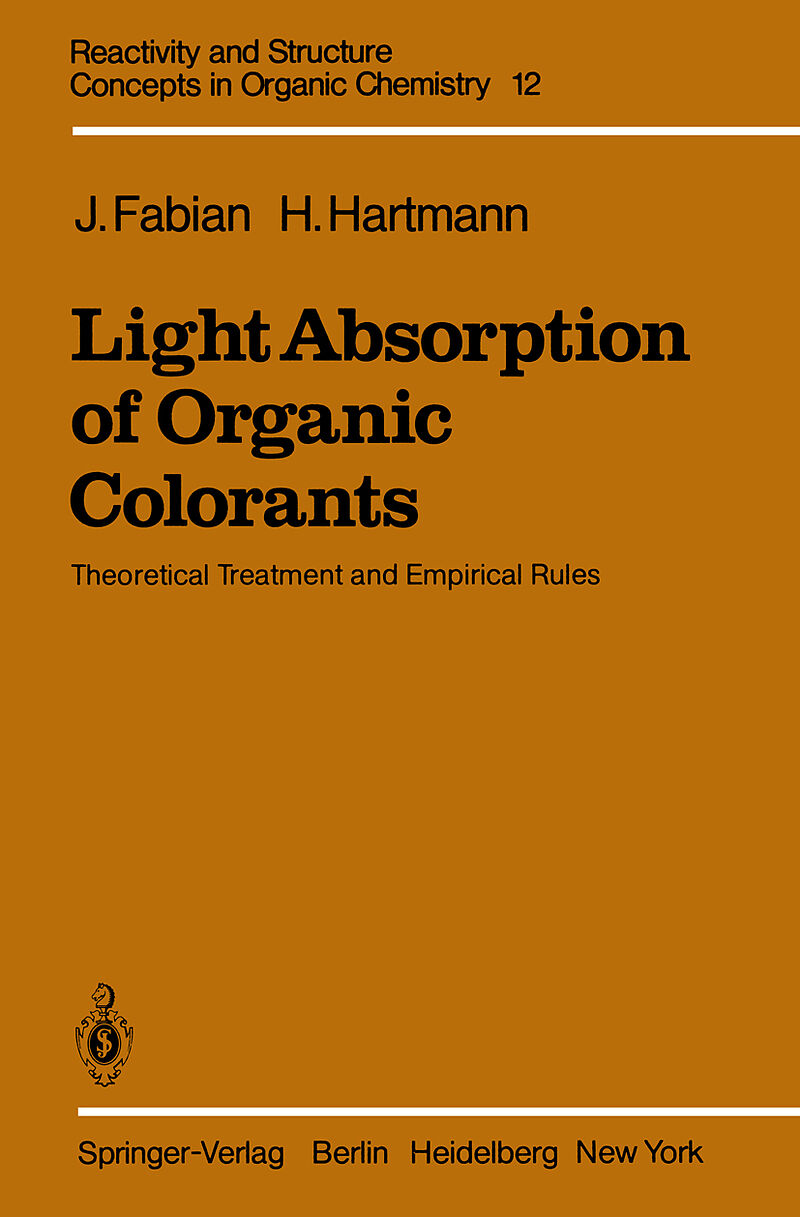Light Absorption of Organic Colorants
Einband:
Kartonierter Einband
EAN:
9783642675898
Untertitel:
Theoretical Treatment and Empirical Rules
Genre:
Chemie
Autor:
H. Hartmann, J. Fabian
Herausgeber:
Springer Berlin Heidelberg
Auflage:
Softcover reprint of the original 1st ed. 1980
Anzahl Seiten:
260
Erscheinungsdatum:
21.01.2012
ISBN:
3642675891
Although studies on synthetic dyes have been performed for more than 100 years, their detailed elucidation requires further extensive research. The discovery of novel high polymers, the necessity of supplying a whole range of shades and increasing require ments for dyestuffs of high fastness properties give rise to a permanent search for new dyes. Extensive investigations on dyes were also occasioned by various applications in the field of spectral sensitization and of staining of biological specimens. Another more recent development concerns the lasing properties of some organic dyes. Most of the progress, however, was only achieved by time-consuming, purely empirical approaches and theoretical understanding of the dye properties is only at its very beginnings. The color is the sine qua non of every dye. For this reason organic chemists and color chemists have looked for relations between the "color and constitution" of dye molecules for a long time. This knowlege as a whole is known as "theory of color". The classic theory of color was established abou t 100 years ago by Witt and was signi ficantly extended 50 years later by W. Konig.
Inhalt
I. Phenomenological Conceptions on Color and Constitution.- II. UV/VIS Spectroscopy and Quantum Chemistry of Organic Colorants.- III. Relation Between Phenomenological and Quantum Chemical Theories.- IV. Theoretical Methods for Deriving Color-Structure Relationships.- 1. PPP-CA Method.- 2. LHM Method.- 3. FMO Considerations.- V. Classification of Organic Colorants.- VI. Polyene Dyes.- 1. Chromophoric System.- 2. Carotenes.- 3. Retinal and Derivatives.- 4. Diarylpolyenes.- 5. Polyenes Bridged by Heteroatoms.- 6. Medium Effects.- VII. Azo Dyes.- 1. Chromophoric System.- 2. Weak Long Wavelength Absorptions.- 3. Azo Compounds with Carbocyclic Groups.- 4. Substituted Azobenzenes.- 5. Polykisazo Compounds.- 6. Heterocyclic Azo Compounds.- 7. Tautomeric Azo Compounds.- 8. Medium Effects.- VIII. Carboximide, Nitro and Quinacridone Dyes.- IX. Quinoid Dyes.- 1. Chromophoric System.- 2. Weak Long-Wavelength Absorptions.- 3. Benzoquinones and Derivatives.- 4. Annelated para-Benzoquinones and Derivatives.- 5. Higher Annelated Quinones.- 6. Medium Effects.- X. Indigoid Dyes.- 1. Chromophoric System.- 2. Indigo and Derivatives.- 3. Indigo-like Compounds.- 4. Medium Effects.- XI. Diphenylmethane, Triphenylmethane and Related Dyes.- 1. Chromophoric System.- 2. Unsubstituted Monoaryl, Diaryl and Triarylmethane Dyes and Vinylogues.- 3. Substituted Arylmethane Dyes and Heterocyclic Analogous.- 4. Heteroanalogous Arylmethane Dyes and Heteroatom-Bridged Derivatives.- 5. Medium Effects.- XII. Polymethine Dyes.- 1. Chromophoric System.- 2. Symmetrical Polymethine Dyes.- 3. Unsymmetrical Polymethine Dyes.- 4. Dyes with Substituted, Bridged and Coupled Chains.- 5. Branches Polymethine Dyes.- 6. Medium Effect.- XIII. Porphyrins and Phthalocyanines.- XIV. Conjugated Betaine Dyes.- XV. Multiple Chromophore Dyes.- References.

Leider konnten wir für diesen Artikel keine Preise ermitteln ...
billigbuch.ch sucht jetzt für Sie die besten Angebote ...
Die aktuellen Verkaufspreise von 6 Onlineshops werden in Realtime abgefragt.
Sie können das gewünschte Produkt anschliessend direkt beim Anbieter Ihrer Wahl bestellen.
Loading...
Die aktuellen Verkaufspreise von 6 Onlineshops werden in Realtime abgefragt.
Sie können das gewünschte Produkt anschliessend direkt beim Anbieter Ihrer Wahl bestellen.
| # | Onlineshop | Preis CHF | Versand CHF | Total CHF | ||
|---|---|---|---|---|---|---|
| 1 | Seller | 0.00 | 0.00 | 0.00 |
